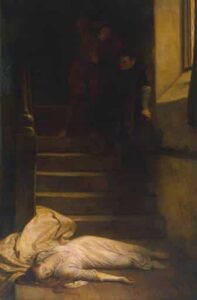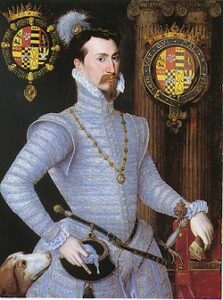
“A historical documentary which explores the possibility that a controversial love affair between Elizabeth I and her confidante Lord Robert Dudley led to a savage murder. It examines remarkable evidence which suggests that Dudley’s wife, Amy Robsart, was assassinated so that her husband could be free to marry the Queen.”
This blurb and the trailer on Channel 5, which features a snippet of an interview with someone who appears to be a medical examiner or pathologist saying that if he had been presented with the evidence he would have advised a full-scale murder enquiry, made me conclude that the programme must be based on the book by Chris Skidmore, “Death and the Virgin: Elizabeth, Dudley and the Mysterious Fate of Amy Robsart” so I did a bit of digging. When I Googled the director, Tom Cholmondeley, I found his online profile which said of “The Virgin Queen’s Fatal Affair: Revealed”:-
“Over the last three years I have worked with rising historian Chris Skidmore to develop a film based around the mysterious death of Amy Robsart.
Amy Robsart was the wife of Elizabeth I’s lover Robert Dudley and when she died the ensuing scandal meant Elizabeth and Robert could never marry.
Chris has discovered new evidence lost for almost 450 years which sheds new light on this coldest of cold cases. Chris shows that Amy Robsart was murdered.”
Chris Skidmore’s Theories
Now, Chris Skidmore’s book has already caused a fair bit of controversy, debate and discussion here at The Elizabeth Files and you can read the articles and comments at:-
But, if you are not aware of this discussion then here is the new evidence that Skidmore puts forward to back up his claim that Amy Robsart’s death was suspicious, and I guess that this is what will be looked at in Thursday’s TV programme:-
- The Coroner’s Report – Amy not only broke her neck but also had two large head wounds which were described as “dyntes”, or blows to the head. According to Skidmore “a sketch of the stairs has also been unearthed. This reveals eight steps, then a landing, followed by another four steps. If Amy fell from the top of these stairs, it seems likely that the landing would have broken her fall. And it does not explain how she could have suffered such extreme head injuries and a broken neck.” Also, she had no other marks on her body which Skidmore finds odd if she fell down the stairs.
- The Staircase – Skidmore argued that a sketch of the staircase revealed that it had “eight steps, then a landing, followed by another four steps” and “if Amy fell from the top of these stairs, it seems likely that the landing would have broken her fall. And it does not explain how she could have suffered such extreme head injuries and a broken neck.” Skidmore went on to say “Interestingly, the sketch does reveal that on the landing there was an interlinking doorway, leading outside – perhaps a perfect getaway for any intruder.”
- The jury – The foreman of the inquest jury was Sir Richard Smith. Smith was known as “The Queen’s Man”, and records show that Robert Dudley, Amy’s husband, gave Smith gifts six years after the trial and that Smith wrote to Dudley before the jury came to their verdict. Skidmore also reveals that Dudley asked that the jury be made up of “discreet” men and that one member of the jury (John Stevenson) was employed by Dudley. Skidmore wonders if the jury really were impartial and whether Dudley may have used bribery.
- Anthony Forster – Robert Dudley paid Anthony Forster, owner of Cumnor Place where Amy died, £310 (around £65,000 in today’s money) shortly after Amy’s death.
- Rumours – There were rumours before Amy’s death that Dudley was arranging his wife’s death.
Counter Arguments
When I discussed Chris Skidmore’s ideas back in March, I had some brilliant counter arguments from Elizabeth Files visitors:-
- Coroner’s report – Christine Hartweg said “it is by no means mysterious that they wouldn’t mention (or even recognize) minor injuries on Amy’s body in those times. Perhaps they hadn’t have a thorough look under her clothes (she was a married woman, after all). Robert Dudley explicitly exhorted Thomas Blount, his steward to whom he wrote his letters after Amy’s death, to press for the jury to thoroughly examine her body! So, perhaps that was not the custom.”
- Richard Smith – Author Robert Parry commented “The gift to Smith and others – It was normal for a man of Dudley’s estate to hand out gifts by way of payment to others. It occurred constantly, on an almost daily basis. Nothing out of the ordinary there. And was it even the same Smith?” Bess Chilver adds: “I can’t see that IF the two Smiths were the same person AND had been nobbled, that he would have waited 6 years for a pay off! It also totally ignores the bald fact that gift giving was a form of currency in the 16th century court.”
- Anthony Forster – Christine Hartweg commented “I’ve just looked up Anthony Forster’s financial dealings with Robert Dudley which he had since at least 1557, when he borrowed over 1,000 pounds from Forster who was later a high-ranking officer in Dudley’s household. In “Household Accounts and Disbursement Books of Robert Dudley, Earl of Leicester” Cambridge UP (1995), the editor, Dr. Simon Adams (the greatest expert on Dudley), lists 300 pounds Dudley received from Forster in May 1559. Adams also comments on 310 pounds Dudley paid to Forster on 16 September 1560, eight days after Amy’s death, and 25 October 1560, in two instalments. Adams thinks the nearness to Amy’s death would perhaps point to ‘expenses of winding up her household’ “.
- Robert Dudley – Robert Parry commented “it must remain very unlikely that Robert would have been culpable in the affair. He was neglectful of his wife, yes, perhaps unkindly so. But it was not uncommon for a husband thus highly placed at court to be away from home for weeks or even months on end. It was part of the job description. Moreover, he knew, as did Cecil and the Queen, that it was sadly (in those days) only a matter of time before Amy succumbed to her illness, and there would have been nothing to gain for him or Elizabeth by having this hastened unnaturally through violent means – in fact quite the reverse.”
- The jury and bribery – Christine Hartweg said “Why bribe the jury if they don’t even bother to write a harmless report? Or otherwise, why should we take serious the coroner’s report if we don’t accept the verdict of that same jury? I wonder why Robert should have been so cunning as to write all those perfectly harmless sounding letters in bad faith or have forged them all when he was so stupid as to leave a trace of allegedly suspicious payment in his account book?”
- The staircase – Bess Chilver took issue with Skidmore’s use of a sketch of the Cumnor Place staircase which he said revealed that it had “eight steps, then a landing, followed by another four steps”. Bess said “I would say there was another landing not in the sketch which doglegged back. Therefore, IF Amy was intending to commit suicide, she would be more likely to throw herself off the upper level which would have her hitting the ground level at the bottom of the described staircase with a great force.”
Bess also said that of Skidmore’s theory relating to the door: “He is making a conclusion based on a sketch that he has not proved (in this article anyway) was made IN THE 16th CENTURY. At best it is a SECONDARY level evidence. He has already said that Cumnor Place has not existed since the 19th century and previously to that was falling down. How can Chris Skidmore state that the door on the landing (assuming it DID exist!) led outside?… The door could merely lead to a small room. If it led outside its on a higher level than the ground so that would mean another series of steps OUTSIDE. Which I think is unlikely to be the case.
Christine Hartweg was so horrified by Chris Skidmore’s theories that she actually wrote a wonderful article arguing against Skidmore’s theories point by point and you can read that at A Response to “Did Robert Dudley Murder Amy Robsart?”
My Thoughts
I haven’t read Skidmore’s book yet (I can’t quite bring myself to!) but from Skidmore’s articles and his interviews, and from the title of this programme “The Virgin Queen’s Fatal Affair”, he does seem to be implicating Elizabeth I in Amy’s death by suggesting that her relationship with Robert Dudley, Amy’s husband, had something to do with it. This really does annoy me because there’s just no evidence to support this and I just cannot see how Dudley or Elizabeth could benefit from Amy’s death in this way. It is clear that Amy was dying so it would have been far better for the couple to wait for her to die naturally, rather than have her die in suspicious circumstances and cause a scandal which, in the end, actually prevented Elizabeth and Dudley from marrying.
Alison Weir has an interesting theory – she wonders if William Cecil actually had something to do with Amy’s death. Weir’s thinking is that Amy’s suspicious death caused a scandal and that made Elizabeth distance herself from Dudley, something that pleased Cecil no end! However,I don’t think Elizabeth I’s most trusted adviser would have risked his mistress’s reputation in that way.
So, what do I think, I hear you asking? Well, I’m torn between three possible scenarios:-
- Suicide – We know that on the day of her death, Amy Robsart ordered all of her servants out of the house, giving them permission to go to Abingdon’s “Our Lady’s Fair” for the day. When some of them protested, Amy was rather sharp with them and asked them to obey her orders. Perhaps Amy was trying to get rid of everyone so that she could put an end to her pain and distress. Her maid did wonder if Amy “might have an evil toy in her mind”, in other words suicide. However, in those days, suicide was regarded as a mortal sin, a sin that led to eternal damnation so Amy would have been risking her soul by committing suicide.
- Accident – This is the one that I’m more drawn to. Amy was very ill and would have been weak and tired so I think it is quite plausible that she had a dizzy spell and simply fell down the stairs. People do not necessarily have to fall a long way for a fall to be fatal, she may have just landed awkwardly and bumped her head on the edges of the stairs on the way down. One interesting theory is Professor Ian Aird’s from 1956, in which he suggests that Amy’s death could have been an accident caused by a spontaneous fracture of the vertebrae as she walked down the stairs. He theorises that Amy’s breast cancer may have caused a weakening of her bones.
- Murder by Person Unknown – I do not believe that Robert Dudley, Elizabeth I or William Cecil arranged for Amy to be killed but if anybody ever proved to me that she definitely was murdered then I would say that it was a plot to discredit Robert Dudley and to prevent him from marrying Elizabeth I.
What are your thoughts?
It certainly looks like “The Virgin Queen’s Fatal Affair: Revealed” is going to be an interesting programme and I will watch it on Thursday and share my thoughts with you on Friday.
More Information
- The Virgin Queen’s Fatal Affair: Revealed – Due to air on Channel 5, 8pm, Thursday 18th November 2010
- A Response to “Did Robert Dudley Murder Amy Robsart?” – Article by Christine Hartweg
- “Death and the Virgin Queen: Elizabeth, Dudley and the Mysterious Fate of Amy Robsart”, Chris Skidmore
- “Suspicious death that made the Virgin Queen” – An article in “The Sunday Times”
- Did Elizabeth I’s lover have wife killed so he could wed the Virgin Queen? – Article in “The Daily Mail”
- “A Tudor Murder Mystery” – Article in “The Daily Express”
- Tudor Murder Mystery Solved – BBC Today interview with Chris Skidmore








